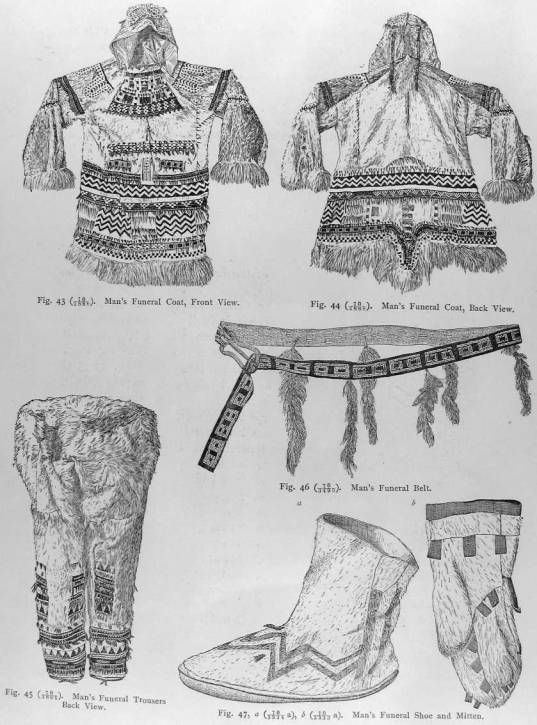
VI. — BIRTH, DEATH, AND FUNERALS.
Birth.
— Before a child is born, the Supreme Being sends into the mother's
womb the soul (uyi'cit) of some deceased relative of the child to be born.
The length of life of each soul is determined beforehand. Souls are hanging
on the cross-beams of the house of The-One-on-High. The duration of the earthly
life of the future possessor of the soul is marked by the strap which
is attached to the soul's neck or thumb. The shorter the strap, the shorter
will be the life of the new-born. A drawing made by the Koryak Yulta,
already described (see Fig. 40, p. 93), illustrates the Koryak idea of souls
hanging in the house of the Supreme Being.
As soon as a child is born, it is given the name of the dead relative whose
soul has been reborn in it. The father of the new-born uses a divining- stone
called Little-Grandmother (An'a'pel) to discover whose soul has entered the
child. The divining-stone is hung by a string to a stick, the latter is lifted,
and the stone begins to swing; or it is hung from a tripod made of small
sticks. The father of the child enumerates the names of the deceased relatives
on his and his wife's side. When the name of the relative whose soul
has entered the child is mentioned, the divining-stone begins to swing quicker.
Another way of determining the identity of the soul is by observation of
the behavior of the child itself. A number of names are mentioned. If the
child cries while a name is pronounced, it shows that it is not the name of
the soul reborn in the child. When the proper name is pronounced, the child
stops crying, or begins to smile. After the name has been given, the father
takes the child in his arms, carries it out from the sleeping-tent into the
house, and says to his people, "A relative has come" (Oaitu'mñin
ye'ti). On
one occasion during our stay in the village of Kamenskoye, a child was named
after the deceased father-in-law of Yulta's son. The latter lifted the child,
and said to the mother, "Here,
thy father has come!"
If a mistake is made in divining the identity of the soul which entered the
new-born child, something will ail the child after it has been named. Then this
mistake may be corrected, and its name is usually changed by means of repeated
divination.
Neither I myself nor my wife was present at a confinement, nor did we witness
the divining while the child was named.1 What I am going to describe here
is recorded from what the Koryak
have told me.
1 In every village, I made inquiries about pregnant women, asking them to call my wife when the confinement should take place, that she might become acquainted with the Koryak methods of midwifery; but the Koryak concealed all births from us. On two occasions women were confined in the villages where we were staying, but we learned of it only post factum.
[100]
101
JOCHELSON, THE KORYAK.
After confinement, the woman is regarded as unclean for a month. During this time she must not take off her shoes in a strange house, nor should she bare her feet in her own house in the presence of strangers. For a year following confinement, she is expected to observe the following food taboos. She must not partake of ringed seal, white whale, fresh fish, or raw thona-seal. She is forbidden to eat whale-meat in the fall, but may do so in the winter. She may eat the boiled meat of a thong-seal caught in the river, but not if it be caught in the sea. A woman, after confinement, is permitted to eat reindeer-meat in any shape or form. There is no doubt that these taboos are intended to prevent the unclean woman from coming in contact with animals that serve as the source of subsistence of the tribe; but it is a striking fact that the taboos are observed in reference to sea-animals only. Other taboos are for the protection of the child. Children in general, and the new-born in particular, are, more than grown-up people, subject to the danger of becoming the victims of the kalau. Children's souls are very shy and inexperienced. The least fright may cause them to leave the body, and, after they have once left, they are unable to find the entrance that leads back into the body. They are also apt to lose their way. Therefore during the entire winter the new-born child must not be taken out of the house, where it is under the protection of the family guardians. In case of absolute necessity, the mother must keep it in her bosom under her coat, and must not take it out when in a strange house. Only after the spring equinox may the child be taken out of the house in safety. The after-birth is put in a bag and hung on a pole some distance away from the village (Plate XII, Fig. 2, opp. p. 97).
Death. — As with all other primitive people, death does not appear to the Koryak as a natural process, — most people are killed by the kalau, — but it happens that the Supreme Being and other supernatural beings may bring about the death of man as a punishment for an infraction of a taboo, or for a failure to offer sacrifice. Shamans frequently inflict death upon men. On the other hand, there is a tradition according to which it was Big-Raven (Ouikinn-a'qu) that caused people to die.
The soul (uyi'cit), or, to be more exact, the chief soul, of the man, frightened by the attack of the kalau upon it, deserts the body, and rises to the Supreme Being. According to some tales, the kala himself pulls the soul out of the human body, and sets it free to go off to the sky, in order to possess himself of the body or of the other souls of the deceased.
Though a man cannot live without a soul, there is apparently some other vital principle, or a secondary soul. I did not learn its name, and heard nothing definite relating to this accessory soul; but some vital principle 1 is
1 Mr. Bogoras says of the Chukchee (Chukchee Materials, p. 17), that they have five or six souls (uwi'rit). Many North American Indians believe that man has two or more souls, while the Yukaghir believe that he has three. As to the Yukaghir, I admit that the conception of these souls has been borrowed by them irom the Yakut, with whom each of the three souls has a name of its own.
102
JOCHELSON, THE KORYAK.
implied in the words wuyi'vi ("breathing") and wu'yil-wu'yil ("shadow"). Further- more, the demarcation between life and death is very ill defined. The dead body is believed not to be deprived of the ability to move. The deceased may arise, if he is not watched. On the Taigonos Peninsula, the Reindeer Koryak told me that a Koryak, by name Ei'gelin, died a few years ago. It so happened that everybody in the house went to sleep, then he arose. When the people awoke, and saw that he was standing, they stabbed him with their knives; but he merely laughed. Then they tried to club him, but were unable to kill him. They dragged him to the fire, but could not burn him. He walked from house to house, saying, "Here, I am leading Ei'gelin." Finally a Russian undertook to burn him. He was given reindeer and a sledge, then he cut Ei'gelin to pieces and carted them away to be burned.
The soul does not leave earth at
once. The person may be dead, but
his soul is soaring high above him. The soul resembles a small fire. It
is
outside of the body during illness. If the illness is slight, the soul
keeps close
above the patient; and if it is severe, it is higher up, and farther away
from
him. Powerful shamans are able to cause the soul to return, and thus
restore
to life a person that has died recently. The Koryak Yulta, from Kamenskoye,
told me that his father had died twice. The first time he died at sunset.
A shaman, summoned from the Livaty settlement, spent all night beating
the
drum; and toward sunrise Yulta's father revived. He lived for a long time
after that. After his recovery he told the people that he had been
walking
all alone in the other world for a long time. Finally he beheld a house,
and
near it he saw his fellow-villager Oatce'pin. He asked him, "How didst thou
get here?" and Oatce'pin replied, "I sold to the Russian chief
two dogs that
I had promised to offer to the Supreme Being. On account of this I died."
It so happened that Oatce'pin died the same night; and when Yulta's
father
revived, wood was being piled up for burning Oatce'pin's body.
Often death is brought about by attacks of the kalau, and it is believed that the kalau cut their victims. It is not quite clear how this is believed to be done. On the one hand, the kala seems to eat human flesh in the most material way, tearing out pieces of flesh from live people, and devouring their internal organs. The Koryak say that he likes human liver particularly well. On the other hand, the body of the deceased, before it is burned, does not show any signs of having been touched by any one. According to the Chuk- chee conception, evil spirits steal the soul (uwi'rit) in order to eat it, and they fatten it before feasting on it.1 We find this conception in a clearer form among the Yakut. The evil spirits eat the soul kut, one of the three souls of men.
The Koryak have also a double conception of the country of the shadows. While the soul rises to the Supreme Being, the deceased and his other soul,
1 Bogoras, Chukchee Materials, p. 17.
103
JOCHELSON, THE KORYAK
or his shadow, depart into the underground world of the shadows, — ancient people, people of former times (Peni'nelau). The entrance into this country is guarded by dogs. If a person beat his dogs during his life, he will not be admitted. These dog-guardians may be bribed, however. For this purpose, fish-fins are put into the mittens of the deceased, that they may give them to the dogs that guard the entrance of the world of the shades. The Peni'nelau live in the underground world in villages, just as human beings live on earth; and relatives live together in the same house. Every new-comer joins his own relatives. The inhabitants of the underground world take care of their relatives on earth by sending them animals, which they kill, and other kinds of food-supply; but they also punish them if they are displeased with them for one reason or another. Presents for dead relatives are put on the pyre when the body of a deceased person is burned. In Tale 43 it is stated that the deceased sent a kala to kill the inhabitants of a village because the young people used to play at night, and disturbed the old people.
As may be seen from many tales, the road leading from earth to the underground world seems to close soon after the passing of the dead. The deceased pass underground through the pyre, and the road closes behind them. In Tale 112 Big-Raven's (Ouikmn'a'qu) daughter purposely permitted herself to be eaten by a cannibal in order to reach the country of the shades, and to bring back, before the road closed again, all the people that had been eaten by the cannibal.
The shadow of the dead, though not visible to all, is conceived of as an absolutely material double of the dead person. It is distinct from the body, of which only the bones are left if the person was eaten by the cannibal kala, or the ashes if the body was burned on the funeral pyre. In former times, communication between our world and the world of the dead was more frequent and less difficult than it is now. Men used to go down on purpose, or strayed there by accident, entering through a crevice in the ground, and came back again. At present, only shamans descend into the underground world.
In olden times, children killed their aged parents. This custom, which still prevails among the Chukchee, is now completely abandoned. In some places, even the recollection of this custom has disappeared. The Maritime Koryak, for instance, deny ever having done so. They insist that this custom prevailed only among the Reindeer Koryak.
The relatives take good care of a dying man. If he is able to eat, he is given the choicest pieces. If the agony lasts long, he is turned on his left side, because they think that thus he will die sooner. If there is another patient in the same house with the dying man, the soul of the former is tied, to prevent its joining the departing soul. For this purpose, the patient's neck is fastened to the bands of the sleeping-tent by means of a string; and the string is charmed so that it may detain the soul.
104
JOCHELSON, THE KORYAK.
The person is declared dead when breathing ceases. Then word is sent from the house where the deceased is lying to all the inhabitants of the village. This is done in the following manner. The messenger ascends to the entrance of each house, and shouts, "Set out a noose!" (Nupã'lhata!) This is done for the purpose of preventing the spirit of death, or the spirit of the deceased, from entering into other houses. The messenger is asked from within the house, " Who is dead ?" and he tells who has died, and goes away. Thereupon a blade of grass or a splinter, which represents a noose, is placed near the head of the ladder. One of the relatives of the deceased holds the head of the dead on his knees until all the inhabitants of the village have been informed. Little children are kept in their mother's or grandmother's arms. After all the neighbors have been informed, the deceased is placed on his bed. In Kamenskoye I was told that the deceased is laid by the side of his former bed. Somebody closes his eyes, and his face is covered with a fur robe. It is a sin to look at the face of a dead person.
Among the Reindeer Koryak, as soon as some one dies, a messenger is sent to the neighboring camps, informing them of the death that has occurred. The sleeping-room cover is removed from over the deceased in the house of the Reindeer Koryak, and the body is covered with a blanket.
Funerals. — The Koryak dispose of their dead by burning.1 The Kamchadal, according to Krasheninnikoff, prior to embracing Christianity, threw away their dead to be devoured by dogs. The Chukchee, to the present time, use both methods of disposing of the dead. They are either burned, or kept to be devoured by wild beasts. The Yukaghir formerly placed their dead on platforms raised on posts.2 The Kerek who live near the mouths of the rivers emptying into the Pacific Ocean, between Capes Anannon and Barykoff, and who have no timber or driftwood for building a pyre, let their corpses, dressed in funeral attire, down into the ocean. They tie the deceased on a long pole, tow it out into the sea, and then push the body into the water with staffs.
In former times, all work in the entire settlement was stopped before the burning of the dead. No one went hunting or sealing, nobody went to fetch wood, and the women did no sewing. At present this custom is not observed
1 Owing to this circumstance, it is impossible to procure Koryak skulls. In the spring of 1900 an epidemic of measles was ravaging the Koryak camps, carrying off numerous victims. Several large families were reduced to only one member. In some camps of the Reindeer Koryak there were so many dead, and such a small number of people who were in good health, that the latter were unable to burn all the dead. They would therefore carry their dead into the wilderness, where they would leave them, together with the reindeer sacrificed to them. Unfortunately it was very difficult to find the remains of the corpses, because, during the entire period of my stay in that region, the whole country was covered with deep snow. Moreover, the Koryak concealed the place whither they had taken their dead. Thus it happened that I found only one whole skull and parts of two others.
2 Both the Yukaghir and the Koryak forms of funeral occur among the North American Indians. The custom of throwing away the dead to be eaten by dogs is met with, according to Prshevalski and Potanin, among the northern Mongols, and in ancient times used to be practised by the Parthians, the Hyrcanians, and the Persians (Jevons, p. 203).
105
JOCHELSON, THE KORYAK
in all the settlements. Only in the house where the body lies is no work done, except the preparation of the pyre and of the funeral clothes for the dead. People from other houses come to assist in this work. The men help in preparing the pyre, and stay up during the night, while the women help in sewing the funeral clothes.
Before being burned, the body is clothed in special, beautifully embroidered funeral garments. The coat is made of the skin of white fawns (thus white appears to be the color appropriate to death); and it is nearly covered with embroidery, especially in front, done with sinew-thread, dyed reindeer-hair and often also with silks of various colors obtained from Russian traders. The funeral garments are also trimmed with fringe and strips made of the soft downy hair of the young seal dyed red, and with little tassels of colored sinew-thread and hair from the reindeer's mane. They are ornamented, besides, with black and white stripes and pieces of soft skin, — the black being from youno-seals, the white from dogs' necks, — also with a border of black and white checks made of the fur of fawns' legs. The trousers and shoes, as well as the quiver for the arrows and the bow-case, and the cap and belt, are ornamented in the same manner. The lower edge of the coat, the sleeves, and the hood are edged with white dog-fur.
The coat of the woman differs from that of the man in that it is made of reindeer-skin with the hair side in. The hide is dyed brown with a solution of alder-bark in urine. The designs on the woman's coat are less complicated, and the embroidery less elaborate, than those on the man's. The way in which these clothes are made will be described in detail later on. Figs. 43-55 show funeral suits of a man and a woman, and a child's funeral cap.
Since it takes a long time to embroider and ornament such a coat, — a woman may be working on one coat an entire winter, — these garments are prepared in advance. Every Koryak has his funeral garment ready, but not entirely finished. It is a sin to finish funeral clothes completely, as, in such case, the person for whom they are intended will die soon. Thus the coat is made ready except the edge of the hood; the boots have no soles; the belt, no buckles, etc.; and after a person dies, a good deal of work remains to be done before the deceased is fully prepared for his journey to the other world. The women of the neighboring houses, under the supervision of some old woman, help in this work. Their final work is done openly, while the preparatory sewing and embroidering of the funeral clothes are done in secret. The women work on funeral clothes mostly at night, when everybody is asleep, or in the daytime if there are no strangers in the house. If a person comes into the house when a woman is sewing on these garments, they are concealed in a bag or under a blanket; for if any one should notice that funeral garments are being made, one of the inhabitants of the house would have to die. On the other hand, funeral garments should be as nice as possible, that the deceased
14—JESUP NORTH PACIFIC EX.PED., VOL. VI.
106
JOCHELSON, THE KORYAK.

107
JOCHELSON, THE KORYAK
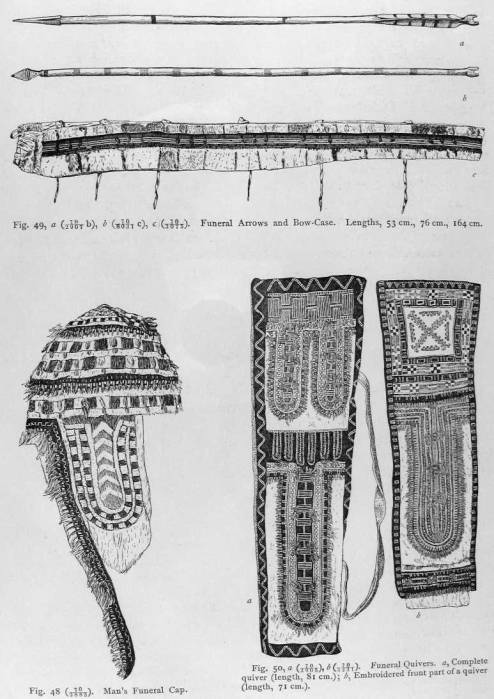
108
JOCHELSON, THE KORYAK.
may have no cause for being displeased with his relatives for not providing him well for his journey. The Koryak of some villages expressed to me their sorrow at having been unable to dress properly their dead who died during the epidemic of measles, which was raging before my arrival, since they had had no time to prepare the required funeral garments. One Koryak was taken ill while travelling, and died in a Russian village near Gishiga. The Russians buried him in a grave in his travelling-clothes. His relatives did not know afterwards what to do with his funeral costume. Being afraid that he might come to get it, they decided to send it to the Russians of the house in which the man died, and thus relieve themselves of their responsibility
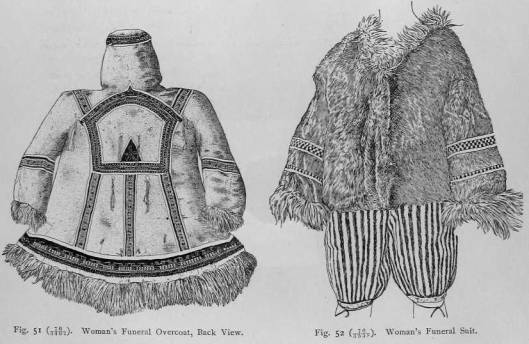
before the deceased. The Russians did not wish to accept it; but the Koryak who had brought it left it on the floor of the house, and drove away. Sub- sequently I bought this costume for our collection.
Since the women of the Reindeer Koryak are less skilful in embroidering than those of the Maritime people, most of the Reindeer Koryak buy the ornamented parts of funeral garments of the Maritime Koryak. It is considered a sin to give away or to sell ready-made funeral clothes. They must not even be carried into a strange house. Only in case a person dies in a neigh- boring house, and his funeral clothes are not ready, is it admissible to give
IO9
JOCHELSON, THE KORYAK.
or sell garments in which the deceased is to be clad. The costume is finished, however, in the house of the deceased. At first none of the Koryak were willing to sell me their funeral clothes. In Paren they were unwilling even to show them to me, considering it a sin. At first, their only reply to all my questions referring to this subject was, that they had no clothes ready. The first costume I succeeded in buying was in Kamenskoye; but matters there were facilitated by the fact that I lived in a separate house (I settled
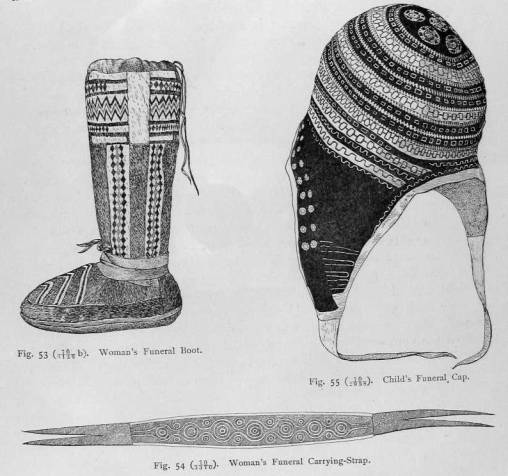
down in the hut of the cossack who is living there by order of the authorities), and the clothes were brought without the knowledge of the other people. In another settlement, when funeral garments were brought to me for sale, I had to go outside to buy them, since the owners of the house in which I stopped, did not wish to have the clothes taken in.
The deceased is not kept in the house long. If the clothes can be finished,
110
JOCHELSON, THE KORYAK.
and fuel provided quick enough, the body is burned on the same day that the person died; otherwise the burning takes place on the second or third day.
While the deceased remains in the house, the people keep awake. The women work on the funeral garments; and the men, in order to keep awake, play cards. At the present time, card-playing, which was, of course, borrowed from the Russians, seems to be considered a necessary part of the formalities to be gone through with in the house of the deceased. The Reindeer Koryak play on the body of the deceased, entertaining him in this manner. While the dead person is in the house, he is considered as a member of the family, and the people try to make it appear as though nothing had happened. It is supposed that he is participating in the meals of the family and in card- playing. It is therefore forbidden to wail for the deceased before he has been taken out. The women weep softly, quietly wiping away their tears.
The deceased is dressed in the funeral garments just before he is taken out. The people put on the clothes in a peculiar manner, to indicate that the dressing of the dead is different from the dressing of living people. For instance, the left-hand mitten is put on the right hand, and vice versa. The cap is put on with its front backward. When hitching up the reindeer which carry the body to the pyre, the Reindeer Koryak put the collar over the right shoulder of the animal, while in ordinary driving it is put over the left shoulder. Before dressing the deceased, one of his nearest relatives — mother, husband, or wife — wipes his face with wet moss, without, however, looking at his face. I had a chance to witness personally the burning of a baby girl who had died soon after birth. After she was dressed, her grandmother took her in her arms and rocked her as though she were alive. Another woman, versed in incantations, waved over the child a little stick to which wool of young seals was tied. In this manner she was driving away the dogs that are believed to guard the entrance into the country of the shades. Then she put a fin of a dried fish into the tiny mitten to give to the guardian dogs. Thereupon she took a little forked alder-branch, charmed it, and gave it to the dead child as a protector (ine'njula'n) and guide on her way. A child may easily lose its way to the other world, and the guardian dogs of the other world are more dangerous to it than to a grown-up person.
The grandmother took the child out, carrying it in her arms; but while she was ascending the ladder, a pole was put down from above through the entrance, and placed alongside of the ladder. It is assumed to be the ladder which the dead child uses. This pole was drawn up while the grandmother was ascending the ladder, and thus they pretended to pull out the little girl.
If a grown person dies, a strap is tied under the arms of the body, which, supported by a relative who ascends the ladder, is drawn out together with the pole, which is supposed to serve the deceased as his ladder. The Reindeer Koryak do not carry out their dead through the usual door, but under the
111
JOCHELSON, THE KORYAK.
edge of the tent-cover, which is lifted up. The ladder used by the dead person, that is the pole, must not be burned, but is thrown away.
The burning-place is not far from the settlement. There is usually a certain place where the bodies are burned. Some families have their particular burning-places. The Reindeer Koryak also burn their dead near camp.
After being taken out of the house, the body is put on a sledge and tied with straps to prevent its getting up. The Maritime Koryak usually draw the sledge themselves; but when there is no wood near the settlement, dogs are hitched to the sledge, and the body is taken to a place where wood can be obtained. On that part of the seashore of the Maritime Koryak which I visited, however, there is driftwood almost everywhere in close proximity. The Reindeer Koryak, on the other hand, hitch the team-reindeer of the deceased to the sledge. These are slaughtered at the pyre, that he may have reindeer in the next world. The meat is eaten by the relatives and neighbors that assemble at the funeral, while the bones are burned on the pyre. Among both the Maritime and Reindeer Koryak it is customary for the neighbors to conduct the body to the burning-place. In some places — as, for instance, in Kamenskoye — women do not go along. During the burning of the child before referred to, I saw only two old women. One of them was the same who had pronounced the incantations, and the other was the dead girl's grand-mother ; and even they left before the pyre was lighted.
The ceremony of burning the child proceeded in the following manner. The grandmother carried the dead child in her arms, followed by the woman mentioned above, who was loaded with various bundles and bags. Next came the men and boys. Every one of them carried a log for the pyre. The burning-place (Me'lgene) was a quarter of a mile from the settlement. When we arrived at the burning-place, the pyre was being built up of rows of drift-wood crossing each other at right angles. The new-comers piled up on it the logs which they had brought along. Two holes were dug near the pyre. The woman conjuror put into one of them the placenta of the girl, and covered it with snow and earth, that the dogs should not dig it up. In the other hole were placed a bag containing the scraps left from the funeral garments, the sweepings from the house, and everything left of the child's things and bedding, so that she should have no cause to come after them. The little girl's body was placed on the pyre, on the right side, as is done with all the dead. Then the straps that tied the legs and the arms were cut. Near the child was placed a piece of steel for striking a light, a woman's knife, an embroidered strap for carrying the woman's bag, a. needle-case, needles, a comb, and some little bells. They put bracelets on her hands, and ear-rings under her cap. The old woman put also a piece of fat by the side of the body. It was to serve as provisions for the deceased. Alongside of the corpse, the old woman conjuror placed a large leather bag with presents for those who had died the preceding
112
JOCHELSON, THE KORYAK.
year. Since during that period there had been an epidemic, and many people had died, many gifts were sent. This was the first burning after the epidemic was over, and every family made use of this opportunity of communicating with the country of the dead, and of sending something to a deceased relative. Every present was wrapped up separately in a piece of bright printed calico or red cloth, and charmed by the conjuror, who in her incantations enumerated for whom each gift was intended. The following articles were among the presents: sugar, tea, tobacco, larch-gum, beads (large and small), bread and biscuit that I had given them at their request, and reindeer meat and fat. Two agaric fungi were sent to one old man who had been very fond of agaric intoxication. No clothing was among the presents, and no fish or seal-meat, or anything connected with hunting at sea or with fishing in the river Apparently the Koryak, like the Eskimo, believe that everything relating to the dead must be kept away from the sea-mammals. After the presents had been given, the women went away, and the men started a fire a little aside from the wood- pile, and with it lighted the pyre in several places. The first fire-brand was placed by the official chief of the settlement (see Plate XIII, Fig. I).
When the clothes were burned, and the child's head appeared, her grand- father took a pole, and, thrusting it into the body, said, "Of yonder magpie pricked" (A'ñalan vaki'tha ti'npinen); or, in a free translation, "This is the magpie of the underworld, which pricked." He imitated the actions of the magpie of the world of the dead, in order to inform the deceased that she was passing to another world, and must not return to the house. The further actions of the dead girl's grandfather had the same end in view. When the flames of the pyre were dying away, he broke some twigs from the alder and willow bushes that were growing near by, and strewed them around the pyre. These twigs represented a dense forest which was supposed to surround the burning-place. We left the place while the pyre was still burning. Before leaving, the grandfather went around the pyre, first from right to left, and then from left to right, in order to so obscure his tracks that the deceased would not be able to follow him. Then, stepping away from the pyre toward the houses, he drew with his stick a line on the snow, jumped across it, and shook himself. The others followed his example. The line was supposed to represent a river which separated the village from the burning-place.
All these actions are identical with episodes in the tales of the "magic flight." After being taken out of the house, the deceased is apparently regarded as a spirit hostile to the living.
The question why and how dead persons become dangerous to those to whom they were near and dear in life, is one of the most difficult ones in ethnology. Fear of the dead is known among all peoples. I did not hear among the Koryak any tales of a direct transformation of a dead person into an evil spirit or kala; but the Chukchee have such tales, and they may also
Jesup North Pacific Expedition, Vol. VI. Plate XIII.
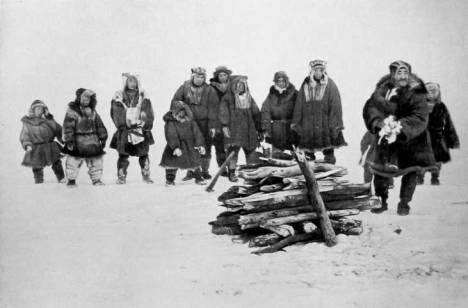
Fig. 1. Cremation of a Child.
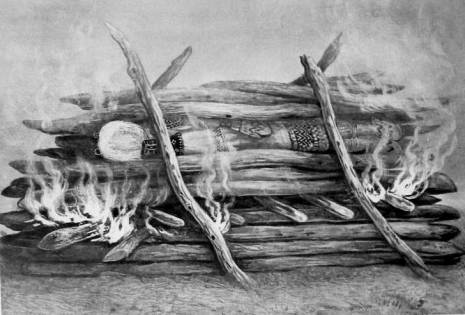
The Koryak.
113
JOCHELSON, THE KORYAK
be found among both North American and Siberian tribes, and in many other parts of the world. The Tupilaq 1 of the Eskimo, and the ghosts of the Indians, are equally pernicious to men. The Yakut,2 Buryat,3 Altaians,4 and Mongol5 hold similar ideas. They believe that souls of certain dead ones turn into evil spirits, which are particularly dangerous to the relatives of the deceased. Such souls are called yör by the Yakut, dakhu'l by the Buryat, usyu't by the Altaians, and evil oñon by the Mongol.
The Reindeer Koryak of the Palpal Ridge dissect bodies before burning them, in order to find out what ailed them. Apparently this custom was in vocrue among other Koryak as well. The Chukchee proceed in the same manner. The usage prevailing in some places, — for instance, among the Reindeer Koryak of the Taigonos Peninsula and the Maritime Koryak of Penshina Bay, — of piercing the abdomen of the corpse with a knife when it is lying on the pyre, and of stuffing the wound with some rags, in cases where death was caused by some internal disease, is to be regarded as a survival of this custom. According to the explanation of the Koryak, this is done for the purpose of guarding the child, which later on receives the soul and the name of the deceased, against the disease of which the departed died.
Immediately after the body has been taken out of the house, the bedding of the deceased is removed, and the place of the dead one is taken by some other inhabitant of the house. For ten days his place in the house must never remain empty, that the kalau may believe they were not successful in their "hunt" among the inmates of the house. The person who occupies the place of the deceased is called by the name of the family guardians, Ine'njula'n. If he leaves the house, somebody else takes his place. In some villages a bundle of grass which has been formed into the shape of a human body, and represents Ine'njula'n, is put in the place of the deceased.
Ten days after a death, the Maritime Koryak beat the drum, thus expressing their grief for the deceased. The Reindeer Koryak beat the drum immediately- after the funeral. I was told in Kamenskoye that all the inmates of the house where a death occurred, and brothers of the deceased, although living in other houses, wear for ten days after the burning charm bracelets or neck- laces braided of sinew-thread and hare's hair as guardians against the spirit of the dead.
Annual obits for the dead are still observed by the Reindeer Koryak of the Palpal Mountains. They consist in the slaughtering of reindeer in honor of the dead, and the piling-up of the antlers on their "graves;" that is, on the burning-places of their relatives. The antlers represent the reindeer-herds
1
Boas, Central Eskimo, p.
591;
and Baffin-Land Eskimo, p.131.
2
Trostchansky,
pp. 82-87; Sieroszevsky,
p. 622; Jochelson, Wandering Tribes, p. 34.
3
Agapitoff
and Khangaloff, p. 24.
4 Potanin,
IV, p. 130.
5 Mikhailovsky, Shamanism, p.
17.
15—JESUP NORTH PACIFIC EXPED., VOL. VI.
114
JOCHELSON, THE KORYAK.
which are sent to the dead in the next world. At present the Reindeer Koryak of Taigonos content themselves, on the whole, with sending presents to the next world by those who have died recently, as is done by the Maritime Koryak. I have not observed any other manifestations of an ancestral cult among the Koryak. There are indications that other forms of disposing of the dead once existed. Two small rough wooden carvings representing female figures (Fig. 56) — one with a child on her back, and the other one with two children (one on her back, and the other at her breast) — were obtained by Mr. Bogoras of two Koryak women from Alutor, who laughed, when giving them away to him, as one would laugh at a thing which has lost all its sacred-ness. According to the statement of these women, however, the figures represent
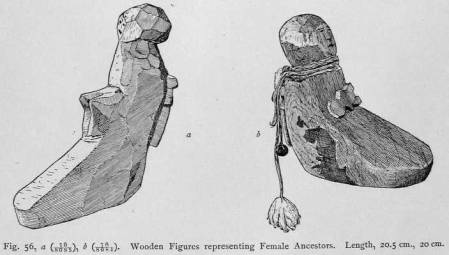
Fig. 56 Wooden Figures representing Female Ancestors. Length, 20.5 cm., 20 cm.
their female ancestor, who was buried, or, to be more exact, who was left dead in her house, together with her child. That such a form of disposing of the dead was in existence in olden times, may also be observed from the myths and from one tradition about Big-Raven (Ouikinn-a'qu), according to which he requested his children to leave him alone in his house after his death.
![]() 1 Tale 65.
1 Tale 65.